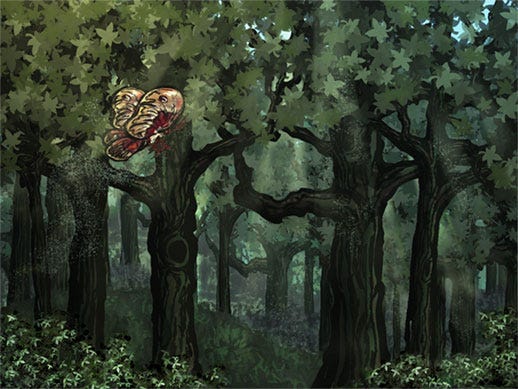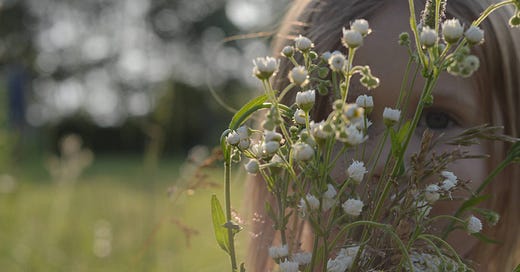Ten years ago, I started telling my then 3 year old a story about a girl named Lisa. It started as these things do—it was bedtime, we’d finished reading our usual ration of books before it was time for lights out…but she begged for just one more story. And since I had already turned the lights off and my eyes were tired from reading, I made up a very short story about a girl called Lisa and her dog Pinocchio, her cat Horace, and her cabin on the side of a mountain. The names hold no special significance other than the fact that they were the first names that popped into my head that night as I was searching my tired brain for what to say. But after that first telling, the “Lisa story” was requested again and again for the next few years. It evolved as verbal stories do, and new characters came into play sometimes, but the bones of the tale remained, which I jotted down a few years after the requests for it stopped so I didn’t forget. There’s a hill in our hayfield that holds the title of “Lisa’s Mountain” and many a play session took place with Lisa’s story as a jumping off point. Someday perhaps the story will make it into a physical, illustrated book that you can hold in your hands—but this year, the year that 3 year old turns 13 and the world is as chaotic as ever, feels like a good time to share it in this digital form. Because you never know when you might need a new story to get through the day.
“Remember on this one thing, said Badger. The stories people tell have a way of taking care of them. If stories come to you, care for them. And learn to give them away where they are needed. Sometimes a person needs a story more than food to stay alive. That is why we put these stories in each other's memories. This is how people care for themselves. ”
― Barry Lopez, Crow and Weasel
There was once a girl named Lisa. She lived in a small wood-walled house, on the outskirts of an alpine village nestled between two mountain peaks. She lived with her mother and father, a Great Pyrenees dog called Pinocchio, and a small orange tabby cat called Horace.
For Lisa and her family, life was pretty ordinary. They got up each morning, went to work or school, ate their meals, did their chores, played outside, tended the garden, and went to bed again at night. Nothing too unusual. Life was not perfect, but it was full of love, and that softened any rough edges.
And like her pretty ordinary life, Lisa was a pretty ordinary girl. She enjoyed playing with her dolls, dressing up, baking cookies, cuddling Horace, throwing sticks for Pinocchio, and sitting on the swing that dangled from the big white pine behind the house. Sometimes she got angry or afraid or sad, sometimes she felt overjoyed and excited, and sometimes she felt calm. Sometimes she got bored. Peanut butter, cheese sticks, and green olives were her favorite foods. She loved to stay up late reading books under the covers with a dog-shaped battery-powered lantern (ssshhhhh, this is a secret). She liked the same things that a lot of kids like. She felt the sort of emotions that most kids feel. Lisa was a pretty ordinary girl.
But she could do something special.
Lisa could dance with mountains.
It all started one day in April when a warm breeze started to make its way into the valley after a long winter. Lisa felt the change in the air and went outside to stand on her front porch in her nightgown. On that early spring morning, the sun was shining brightly, and there were birds chirping in the forest around the cabin. Frogs croaked along the banks of the creek as the water meandered down the center of the valley. There were new sounds all around.
She started listening closer to all the sounds that swirled around her on the porch, and since she was a curious girl, she began to wonder what they were saying.
Hopping off the last porch step, she walked to the edge of the woods and listened even closer.
She heard the breeze whispering through the tall white pines, and she heard a rustling from the forest floor as chipmunks scurried through last year’s fallen leaves. She heard the cry of a hawk circling overhead, and she heard a low sigh as a harder gust of wind groaned through the valley. She heard a tiny rock fall from the cliff to her right as a marmot peeked his head out of his lair, and she heard the song of the creek as it rushed to lower elevation. She stood with her bare feet on the cold ground and felt the earth below. She welcomed the sun on her face and the tingle of fresh air on her ankles. She felt energy like she had never felt before.
She danced with the mountain that day.
And she continued to dance, because the mountain kept talking to her and inviting her to. All she had to do was remember to notice. And listen.
Sometimes she didn’t remember, and after a while of not remembering, she felt like something was not quite right. Luckily the mountain was good about giving her invitations to pay attention. An unexpected rainstorm or waking up to a morning covered in sparkling white hoarfrost always reminded Lisa that mountains had voices and wanted to tell her stories.
As the seasons changed, the stories the mountain told her changed, too.

In spring, the stories were full of excitement and anticipation. Lisa rushed out in the mornings, because she could hear the mountain cheering and splashing and playing in the rushing water as the snowpack started to melt. She noticed the rhubarb her father had planted before she was born was starting to tickle the surface of the soil, little red and greenish tendrils peeking out into the wild air. She heard the mountain sigh in relief that there was something new coming into being. She and the mountain danced a dance of newness, and shared stories of beginnings.
In summer, the mountain told stories of abundance and light. Lisa learned to hear the mountain speak through light green tips of new growth on the tiny pine trees by her favorite path in the forest, through crimson morning glories that crept up the south side of the cabin, through brightly colored butterflies slurping nectar, through wild raspberries that stained her fingertips, and through the black bears who shared her love of such delight. She heard the mountain gather strength and offer full displays of beauty. She and the mountain danced a dance of celebration, and shared stories of exuberance and delight.
In autumn, the stories were full of gathering and storing and preserving, as Lisa and her family (along with the woodland creatures), harvested the garden and foraged in the woods for foods to put up for winter. Lisa learned from the mountains to see opportunity in transition as the aspen leaves changed to brilliant yellow and gold. The mountain showed her how to let things go as the trees dropped those leaves to the ground. She and the mountain danced a dance of renewal, and shared stories of harvesting goodness and sharing bounty.
And in winter, as the mountain settled in for a long slumber, Lisa heard stories of rest and seeking wisdom from stillness. As ice formed on the creek and snow cloaked the trees in bright white, Lisa listened to the earth slow down. She learned to listen for what the mountain was truly saying. She and the mountain danced a dance of peace, and shared stories of embracing slowness and patience.
Lisa learned that the mountains are a part of her.
She learned that she has always been a part of the mountains.
She danced with the mountains.
She still does, in fact.
And the secret she wants to share with you is that you can do it too. No matter where you live, be it near mountains, lakes, rivers, forests, deserts, or prairies, next time you go outside, listen. If you live in a big city, look all the way up at the sky. You might just hear the earth sharing a story, and when you hear that, the dance has begun.
Speaking of children’s books, two authors whose work I admire very much, and who both offered endorsements of Church of Shadow and Light, have both written children’s books, which you can, in fact, purchase and hold in your hands.
Meghan J. Ward wrote The Wonders That I Find, and Kaitlin B. Curtice wrote An Indigenous Celebration of Nature — a children’s book series. (Spring’s Miracles comes out on March 4!)
Here are their endorsements.
"Poetry is meant to stretch us beyond what we know or understand, and Church of Shadow and Light does just that. Heidi Barr is a prophetic poet and a kind of spiritual guide, leading us deeper into the world and thus deeper into ourselves. When Heidi asks who or what the Divine is, I listen. I’m so grateful for this book of poetry; I’ll be returning to its images, its essence, and its medicine again and again."
- creator of The Liminality Journal
"The human experience has been bonded through generations by the conflicts that define us, shift our priorities, and perpetuate under the disguise of new forms. Yet amid the struggles, we have also been united by moments of lightness, when divinity peeks in on our mortal existence and shows us there may be a different way forward. Through Heidi Barr’s transcendent poetry of Church of Shadow and Light, we have an opportunity to soak in that liminal space between what feels like opposites. It is a sorrowful yet beautiful call to consider how we might show up, even when it hurts."
- creator of Field Notes





I used to make up stories to tell my kids. Often I'd ask one or two of their stuffed animals to help me. My kids loved these silly stories, but it didn't matter that they were silly. All that mattered was that we were playing. I think they liked to see me have fun and act silly like I was, well, just like them. My daughter reminded me of this not long ago. What fun it was. Such great memories.
Thank you for bringing this lovely episode to life for us.
Thank you for sharing that very moving story. It touched my heart and spirit deeply. I can really relate to it….my deep love for nature, a healing place that always supports and loves me. I’m so grateful for this magical and moving story you created for your daughter. I’m touched…profoundly….